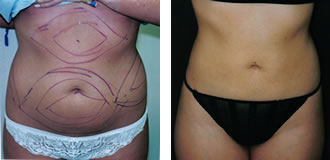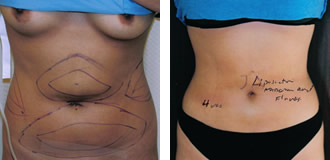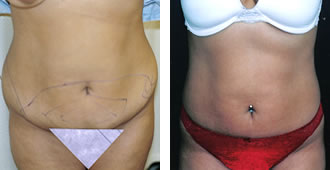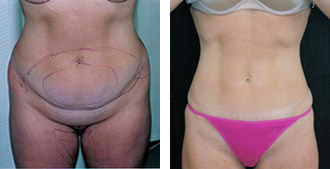REVISION LIPOSUCTION (LIPOSUCTIONING TUMESCENT TECHNIQUE)
Posted On: September 08, 2014 Author: The Office of Dr. Stuart Linder Posted In: Liposuction, Plastic Surgery
Revision liposuction has become a very significant part of my practice. Patients come in from throughout the country and in fact, throughout the world, who desire to have revision liposuction in order to improve a previous result.
There are two problems that I see uniformly. One is inadequate liposuctioning in specific designated localized fat deposit areas or over-liposuctioning in areas where suctioning is performed too close to the subdermis leading to indentations and contour deformities of the skin. The first problem of inadequate liposuction is very common, especially with surgeons who are inexperienced or do not have judgment with liposuction. Only Board Certified Plastic and Reconstructive Surgeons should be performing liposuctioning at any time. The skill of the abdominal wall, the thighs or the lateral breasts requires years of experience and training in both general surgery as well as plastic and reconstructive surgery. Liposuctioning the localized deep fat deposit areas will allow for smoothing and reduced risk of contour deformity.
There are two fat deposit areas, 1) the superficial fat, referred to as Camper’s fascia; and 2) the deep fat, referred to as Scarpa’s fascia. Only Scarpa’s fascia should be suctioned and only deep portions of the Camper’s fascia should be suctioned in order to prevent skin irregularities and contour deformities.
Patients who present with under-suctioning in areas such as the hips, abdomen, periumbilical, lower and lateral thighs are usually unhappy that they don’t see a significant change in the appearance of their bodies that they were hoping for. When I perform liposuctioning, in our Beverly Hills Surgery Center, of the abdominal area I am very careful to remove fat in the hip and flank areas in order to smooth out the contour of the midriff area. When there is a significant amount of fat in the iliac crest roll or the hip regions, this can be taken care of by and what I refer to as the Linder Bi-Directional Liposuction Technique, removing fat both in a vertical and oblique fashion along the iliac crest roll or hips. This completely changes the boxy appearance into a smoother contour and reduces fat above the jean line. Women who wear low-cut jeans enjoy this result because it reduces that hip bulge above the jeans. Liposuctioning of the lower abdominal and periumbilical area depends upon the amount of skin laxity. If it is not significant and there is good skin tone, then suctioning should be significant and somewhat aggressive in order to smooth this area out. Using an abdominal binder for six weeks will help to allow for skin tightening as well.
Liposuctioning of the thighs requires a significant amount of skill, especially the medial thighs which can end up with loose skin as well as contour deformities greater than the lateral. The reason is the medial fat of the medial thighs is more of a looser fat, a softer fat. The thigh fat along the lateral thigh is a denser, compact fat which usually can be suctioned with less contour problems. Suctioning should only be performed in the deep fat deposit areas in the both the medial and lateral thighs. With revision liposuction there is often a significant amount of scarring internally and this can make it more difficult to smooth out certain areas, as well as more difficult to maintain your plane of direction.
Secondly, over-liposuctioning. Patients who present who have had over-suctioning performed by other surgeons are more difficult to fix in that these areas may require fat grafting or simply feathering of these areas to smooth out the fatty deposits that were left behind in specific areas. It can be very dangerous to perform secondary liposuction on an area where the tissue is less than 1 cm thick in that you can end up with inadequate blood supply and subdermal vascular necrosis which can lead to death of the skin. Therefore, when considering secondary liposuction of areas that are over-suctioned, an experienced Board Certified Plastic Surgeon is a must in order to prevent a catastrophe.
This will go on drlinder.com article entitled “Liposuction Revision for Inadequate Liposuction versus Over-Suctioning.”



